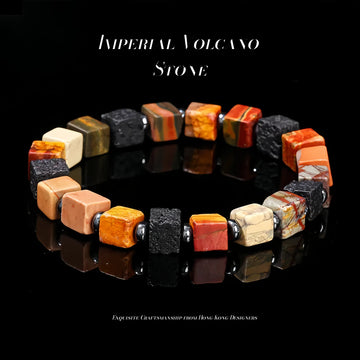Precautions for men wearing stone bracelets during outdoor activities
When wearing stone bracelets for outdoor activities, it is necessary to take into account safety, comfort and the characteristics of stone. The following suggestions are provided from four aspects: material selection, wearing method, environmental adaptation and maintenance:
First, material selection: balancing durability and safety
Give priority to choosing stones with high hardness
Recommended materials: Obsidian (hardness 5.5-6), agate (hardness 7), Hetian jade (hardness 6-6.5
Avoid materials: turquoise (hardness 5-6), coral (organic matter, fragile), malachite (hardness 3.5-4)
Case: Wearing a malachite bracelet while rock climbing may cause it to shatter and scratch the skin due to impact.
Consider the density and weight of the stone
Lightweight stones: Obsidian, agate (density approximately 2.6-2.7g/cm³)
Heavy stones: Tiger's eye (density approximately 3.0g/cm³), lapis lazuli (density 2.7-2.9g/cm³)
Suggestion: When hiking for a long time, give priority to choosing lightweight stone to reduce the burden on your wrists.
Second, wearing method: Ensure freedom and safety of movement
Adjustment of tightness
Standard: The inner diameter of the bracelet should be 1 to 1.5cm larger than the wrist circumference to prevent it from being too tight and affecting blood circulation, or too loose and causing it to slip off.
Test method: The bracelet can be easily turned after wearing, but it will not slide on the wrist.
Fixation and protection design
Recommended Design:
Open-type bracelet (convenient for quick putting on and taking off)
Silicone lining (reduces the friction between metal and stone on the skin)
Anti-slip patterns (such as bamboo joint patterns or rope knot designs)
Case: Wearing a bracelet with a smooth surface while cycling may cause it to slip due to sweat.
Avoid wearing bracelets on one side
Risk: Wearing it on one side may cause the bracelet to collide with objects due to imbalance in movement, increasing the risk of damage.
It is recommended to wear it symmetrically on both sides or only on the non-primary wrist.
Third, environmental adaptation: Cope with complex outdoor conditions
Extreme temperature and humidity
Low-temperature environment: Avoid wearing stones with high moisture content (such as turquoise), as they may crack due to cold shrinkage.
High-temperature environment: Keep away from open flames or high-temperature surfaces to prevent the stone from cracking (for example, obsidian may crack due to uneven heating).
Humidity changes: Avoid frequent entry and exit from environments with large temperature differences (such as entering an air-conditioned room after hiking in the rainforest), as the stone may develop cracks due to thermal expansion and contraction.
Protection against chemical substances
Avoid contact with: acidic substances (such as lemon juice), bleach, cosmetics (containing alcohol)
Protective measures: Remove the bracelet before applying sunscreen or mosquito repellent, or wear a waterproof wrist guard to cover the bracelet.
Activity type matching
High-intensity sports (such as mountain climbing and rock climbing) : It is recommended to wear stone bracelets made of knots or woven materials to reduce the risk of bumps from metal accessories.
Water activities: Choose bracelets lined with resin or silicone with good waterproof performance to prevent seawater from corroding the stone.
Fourth, maintenance and care: Extend the service life of the bracelet
Daily cleaning
Method: Use a soft-bristled brush dipped in clean water or neutral detergent to gently brush. Avoid using an ultrasonic cleaner (which may crack the stone).
Frequency: Clean immediately after outdoor activities to prevent sweat stains and dust residue.
Storage suggestions
Separate storage: Place each bracelet separately in a flannel bag to avoid mutual friction and scratches.
Moisture-proof and dust-proof: Store in a dry environment, away from volatile substances such as camphor balls.
Regular inspection
Inspection contents:
Are there any cracks or notches in the stone
Check if the metal fittings (such as rings) are loose
Whether the knot or braided part is worn
Suggestion: Conduct a quick check before each outdoor activity.
Fifth, strategies for dealing with special scenarios
Nighttime outdoor activities: Avoid wearing highly reflective stones (such as moonstone), as they may attract insects or affect night vision.
Emergency: Carry portable tools (such as a multi-functional knife) to quickly cut knots or remove bracelets.
Cultural taboos: In religious sites (such as mosques) or tribal areas, it is necessary to learn in advance about the local taboos regarding the wearing of stone (for example, in some cultures, men are prohibited from wearing coral).
Summary
When men wear stone bracelets for outdoor activities, they should give priority to choosing stones with high hardness, light weight and anti-slip properties, and pay attention to adjusting the tightness and environmental protection. Through regular maintenance and scene adaptation, it is possible to balance individual expression and outdoor functional requirements while ensuring safety.







